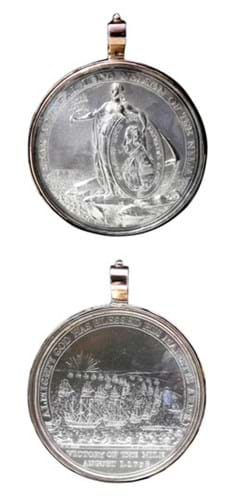
It will be offered in a sale of fine art and antiques on November 9-10 and is estimated at £10,000-15,000.
The officer class Davison's Nile Medal was awarded to Thomas Atkinson (1768-1836), whom Nelson described as "one of the best Masters I have seen in the Royal Navy".
Atkinson served with Nelson throughout the Napoleonic Wars and is reputed to have held him when Nelson had his arm amputated following the attack at Santa Cruz.
The two men were clearly close friends, Nelson being godfather to Atkinson's son, whom he named Horatio Nelson Atkinson. Atkinson is pictured in paintings depicting the death of Nelson. He wrote a full account on the incident in the ship's logbook before returning Nelson's body to England on board the Victory for his state funeral.
Yorkshire-born Thomas Atkinson was born in Richmond and joined the Royal Navy aged 20 in 1787. On the declaration of war with France in 1793 he served on various ships, seeing action in the Channel and was present at the Battle of Cape St Vincent in 1797, after which Nelson, already Duke of Bronté, was made a Knight of the Bath.
Shortly afterwards, Atkinson was appointed Master of the Theseus and served under Nelson on the failed amphibious assault on Santa Cruz, Tenerife, which resulted in the loss of several hundred casualties. Nelson himself was wounded by grapeshot in the right arm. He was carried back to the Theseus, where Atkinson is said to have helped hold him while the ship's surgeon carried out the amputation.
The following year, Nelson won a decisive victory over the French at the Battle of the Nile. Theseus was the fourth ship to round the French vanguard and attack from an inshore position.
In 1799, Atkinson distinguished himself when, despite being wounded, he helped prevent fire caused by an accidental explosion at Acre in Egypt which killed the ship's captain. Although severely damaged, Theseus still made a determined pursuit of enemy ships.
In 1801, Atkinson was Master of the St George, which was present at the Battle of Copenhagen, and it was there that Atkinson earned praise from Nelson. The certificate, written in Nelson's own hand, read: "I certify that Mr Thomas Atkinson is capable of being Master of any First Rate and I recommend him as one of the best Masters I have seen in the Royal Navy."
The short-lived Peace of Amiens enabled Atkinson to return to his wife and nine-month-old son, but on March 15, 1803, he received a handwritten note from Nelson which read: "I shall be very happy to have you with me should a war take place and will write to the Navy Board to that effect." War with France was declared on May 18, by which time Atkinson was already aboard the Victory, joining Nelson who had been appointed to the Mediterranean command.
The Battle of Trafalgar was Britain's greatest naval victory and Atkinson's greatest challenge. Canon fire shot away Victory's mizzen-topmast and the ship's wheel, disabling her steering. Atkinson went below and with the help of First Lieutenant John Quilliam, he operated the tiller from the gun room throughout the battle.
Before the battle Nelson had promised Atkinson promotion, but this could not be fulfilled, Nelson being fatally wounded by a French sniper. After returning Nelson's body to Chatham, Atkinson was honoured by being picked to attend the state funeral. On January 16 1806, he signed off on the last page of the log book: "At Sun Set. Hauled down the Pendant, the Ship being out of commission. Thomas Atkinson, Master". He never sailed as Master again.
He was subsequently appointed King's Harbour Master of Portsmouth, a post he held until his death in 1836. With his wife Agnes, he had a family of three sons, each of whom obtained Royal Navy commissions, and three daughters.
Atkinson's silver Nile Medal is inscribed from Alexr Davison Esqr. St James's Square, A Tribute of Regard.
Nelson appointed Alexander Davison as sole prize agent for the ships captured at the Battle of the Nile and Davison had medals struck from the profits he obtained. Specimens in gold were presented to Nelson and his captains. Silver versions went to lieutenants and warrant officers, gilt copper medals went to petty officers and the seamen and the marines' medal was copper.
Atkinson's medal will be offered together with the Baltic Medal, 1856 engraved W.G. Atkinson, Master's Assistant HMS Arrogant and a Greenwich Hospital Nautical School Medal for Science and Good Conduct engraved H.N. Atkinson 1857.
Horatio Atkinson joined the Navy in 1817 passing his examinations in 1824. He is listed as receiving "severe gunshot wounds" at Seringapatam, as well as displaying "the upmost gallantry" during the capture of two Greek vessels in the Negropont Channel. He was promoted to Lieutenant in 1827 and served in the Mediterranean until 1836, where he witnessed the establishment of King Otho on the Throne of Greece and was presented with a sword by Mahemet Ali.
The three medals have been sent for sale by a private collector and naval historian who is a past archivist/librarian of The Nelson Society. He has conducted extensive research into Thomas Atkinson and the Atkinson family, which will be sold alongside the medal. It includes copies of family history listings, wills, marriage certificates, Thomas Atkinson's record of service as well as facsimiles of the musters for ships HMS Blonde and Rattler, together with pay books for HMS Hannibal and Rattler on which Thomas Atkinson served.
By Ivan Macquisten




